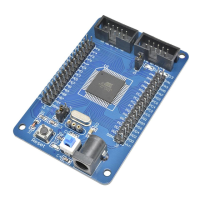94
2467S–AVR–07/09
ATmega128
tive when no clock source is selected. The output from the clock select logic is referred to as the
timer clock (clk
T0
).
The double buffered Output Compare Register (OCR0) is compared with the Timer/Counter
value at all times. The result of the compare can be used by the waveform generator to generate
a PWM or variable frequency output on the Output Compare Pin (OC0). See “Output Compare
Unit” on page 95. for details. The compare match event will also set the compare flag (OCF0)
which can be used to generate an output compare interrupt request.
Definitions Many register and bit references in this document are written in general form. A lower case “n”
replaces the Timer/Counter number, in this case 0. However, when using the register or bit
defines in a program, the precise form must be used (i.e., TCNT0 for accessing Timer/Counter0
counter value and so on).
The definitions in Table 51 are also used extensively throughout the document.
Timer/Counter
Clock Sources
The Timer/Counter can be clocked by an internal synchronous or an external asynchronous
clock source. The clock source clk
T0
is by default equal to the MCU clock, clk
I/O
. When the AS0
bit in the ASSR Register is written to logic one, the clock source is taken from the Timer/Counter
Oscillator connected to TOSC1 and TOSC2. For details on asynchronous operation, see “Asyn-
chronous Status Register – ASSR” on page 107. For details on clock sources and prescaler, see
“Timer/Counter Prescaler” on page 110.
Counter Unit The main part of the 8-bit Timer/Counter is the programmable bi-directional counter unit. Figure
35 shows a block diagram of the counter and its surrounding environment.
Figure 35. Counter Unit Block Diagram
Table 51. Definitions
BOTTOM The counter reaches the BOTTOM when it becomes zero (0x00).
MAX The counter reaches its MAXimum when it becomes 0xFF (decimal 255).
TOP The counter reaches the TOP when it becomes equal to the highest
value in the count sequence. The TOP value can be assigned to be the
fixed value 0xFF (MAX) or the value stored in the OCR0 Register. The
assignment is dependent on the mode of operation.
DATA BU S
TCNTn Control Logic
count
TOVn
(Int.Req.)
topbottom
direction
clear
TOSC1
T/C
Oscillator
TOSC2
Prescaler
clk
I/O
clk
Tn

